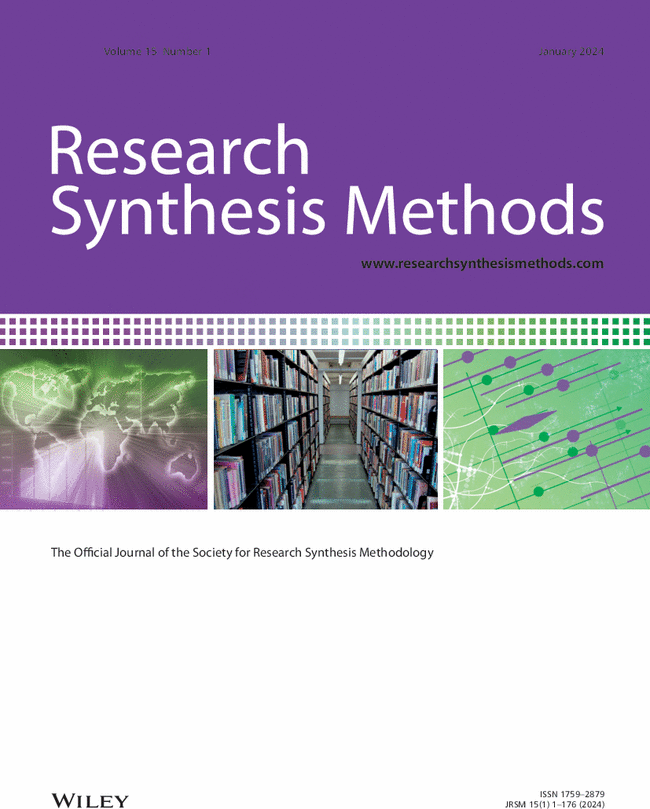对中断时间序列研究中用于荟萃分析结果的统计方法的评价:模拟研究
IF 5
2区 生物学
Q1 MATHEMATICAL & COMPUTATIONAL BIOLOGY
引用次数: 0
摘要
中断时间序列(ITS)经常被荟萃分析,为公共卫生和政策决策提供信息,但在这种情况下,对ITS分析和荟萃分析的统计方法的研究是有限的。方法对具有连续结局数据的ITS研究进行meta分析,使用分段线性回归和两种估计方法[普通最小二乘法(OLS)和限制最大似然(REML)]对研究进行分析,并使用固定效应和(多)随机效应meta分析方法对直接水平和斜率变化效应估计进行meta分析。仿真设计参数包括变序列长度;lag-1自相关的大小;水平和坡度变化幅度;纳入研究的数量;效应大小的异质性。结果所有的荟萃分析方法都得出了中断效应的无偏估计。无论使用ITS分析方法和其他设计参数如何,所有随机效应荟萃分析方法的覆盖率都接近名义水平。然而,在ITS研究标准误差被低估的情况下,异质性经常被高估,这种情况发生在短序列或ITS分析方法没有适当考虑自相关的情况下。结论荟萃分析方法的效果取决于纳入ITS研究的设计和分析。尽管所有随机效应方法在覆盖范围方面表现良好,无论ITS分析方法如何,我们建议使用从ITS方法计算的效应估计,并在可能的情况下调整自相关。这样做可能会导致对异质性方差的更准确的估计。本文章由计算机程序翻译,如有差异,请以英文原文为准。
Evaluation of statistical methods used to meta-analyse results from interrupted time series studies: a simulation study
Background Interrupted time series (ITS) are often meta-analysed to inform public health and policy decisions but examination of the statistical methods for ITS analysis and meta-analysis in this context is limited. Methods We simulated meta-analyses of ITS studies with continuous outcome data, analysed the studies using segmented linear regression with two estimation methods [ordinary least squares (OLS) and restricted maximum likelihood (REML)], and meta-analysed the immediate level- and slope-change effect estimates using fixed-effect and (multiple) random-effects meta-analysis methods. Simulation design parameters included varying series length; magnitude of lag-1 autocorrelation; magnitude of level- and slope-changes; number of included studies; and, effect size heterogeneity. Results All meta-analysis methods yielded unbiased estimates of the interruption effects. All random effects meta-analysis methods yielded coverage close to the nominal level, irrespective of the ITS analysis method used and other design parameters. However, heterogeneity was frequently overestimated in scenarios where the ITS study standard errors were underestimated, which occurred for short series or when the ITS analysis method did not appropriately account for autocorrelation. Conclusions The performance of meta-analysis methods depends on the design and analysis of the included ITS studies. Although all random effects methods performed well in terms of coverage, irrespective of the ITS analysis method, we recommend the use of effect estimates calculated from ITS methods that adjust for autocorrelation when possible. Doing so will likely to lead to more accurate estimates of the heterogeneity variance.
求助全文
通过发布文献求助,成功后即可免费获取论文全文。
去求助
来源期刊

Research Synthesis Methods
MATHEMATICAL & COMPUTATIONAL BIOLOGYMULTID-MULTIDISCIPLINARY SCIENCES
CiteScore
16.90
自引率
3.10%
发文量
75
期刊介绍:
Research Synthesis Methods is a reputable, peer-reviewed journal that focuses on the development and dissemination of methods for conducting systematic research synthesis. Our aim is to advance the knowledge and application of research synthesis methods across various disciplines.
Our journal provides a platform for the exchange of ideas and knowledge related to designing, conducting, analyzing, interpreting, reporting, and applying research synthesis. While research synthesis is commonly practiced in the health and social sciences, our journal also welcomes contributions from other fields to enrich the methodologies employed in research synthesis across scientific disciplines.
By bridging different disciplines, we aim to foster collaboration and cross-fertilization of ideas, ultimately enhancing the quality and effectiveness of research synthesis methods. Whether you are a researcher, practitioner, or stakeholder involved in research synthesis, our journal strives to offer valuable insights and practical guidance for your work.
 求助内容:
求助内容: 应助结果提醒方式:
应助结果提醒方式:


